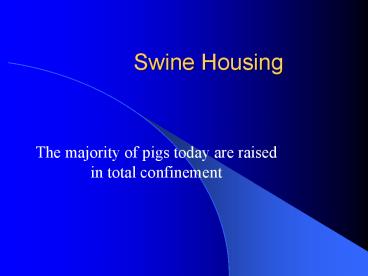Swine Housing - PowerPoint PPT Presentation
1 / 17
Title:
Swine Housing
Description:
Swine Housing The majority of pigs today are raised in total confinement Confinement Production What are some of the advantages and disadvantages of raising swine in ... – PowerPoint PPT presentation
Number of Views:349
Avg rating:3.0/5.0
Title: Swine Housing
1
Swine Housing
- The majority of pigs today are raised in total
confinement
2
Confinement Production
- What are some of the advantages and disadvantages
of raising swine in confinement?
3
Advantages
- Less labor per cwt of pork produced
- A more stable environment
- Fewer parasites
- Less disease problems
- Increased productivity
4
Disadvantages
- Buildings and equipment are very expensive
- Energy costs
- Reproductive problems
- Waste disposal
5
Waste Handling
- Manure disposal is a critical part of raising
pigs in total confinement (3-4 T/200 lb hog/yr. - Typical methods of handling waste in confinement
buildings include - Gutter flush to a lagoon
- Manure pit
- Mechanical scraper
6
Floors in Swine Buildings
- Solid concrete
- Partially slotted
- Total slotted
- Expanded metal
- Plastic coated expanded metal
- Plastic
7
Farrowing Facilities
- In the past individual farrowing houses were
quite common when sows and pigs were raised on
pasture - Today most farrowing houses are central in
design. - Central farrowing houses consist of one or more
rooms that accommodate groups of sows
8
Farrowing House Continued
- Most producers use farrowing crates
- Years ago the majority of sows were kept in
individual pens prior to and after farrowing - Crates are preferred today because they result in
more pigs weaned per litter
9
Nursery Facilities
- Nursery barns often contain several rooms with
each room designed to accommodate the number of
pigs from an individual farrowing room - Small pens designed to handle 6 to 8 pigs are
very common although some pens may be large
enough to handle 16 to 25 pigs
10
Nursery Building Continued
- The facilities are designed to provide a fairly
stable environment - These facilities may be designed to accommodate 3
week old pigs or perhaps 10 d old pigs - Supplemental heat is provided via heat lamps,
radiant heaters or perhaps heat in the floor
11
Grow-Finish Facilities
- Environmentally enclosed (totally enclosed)
buildings are the most popular today - Open-front buildings popular in the 60s
- Modified open front (MOF) buildings were popular
in the 80s - Hoop buildings are the most recent
- Space requirements of 8-10 sq.ft./hd for G-F
12
Waterers
- Nipple waterers are very popular in confinement
- Water cups are also popular
- Some buildings (particularly gestation buildings)
may use a concrete feed trough as a place to
provide water after feeding - Rule-of-thumb provide one waterer/15 pigs
13
Feeding Equipment
- Self feeders are generally used for nursery and
grow-finish pigs - Breeding stock are generally limit fed via floor
feeding or in self feeders - Pigs per feeder space range from 2 for nursery
pigs to 4-5 for finishing pigs.
14
Terms you should know
- Segregated early weaning (SEW)
- Split-sex feeding
- Phase feeding
- Multiple-site systems
- All-in-all-out (AIAO)
15
Terms defined
- SEW refers to weaning the pigs at 10-14 days of
age when they are still protected from diseases
via passive immunity from the mothers milk.
These pigs are removed from the sow and placed in
a separate building.
16
Terms continued
- Split-sex feeding refers to feeding gilts and
barrows separate since gilts are normally leaner
than barrows and as a result have a higher
protein requirement. - Phase Feeding refers to frequent changes in the
diet to more closely meet the specific nutrient
requirements for various weight groups.
17
Terms continued
- Multiple-site systems generally refers to
having a different location for
breeding-gestation-farrowing versus nursery
versus grower-finishing. - AIAO refers to a management system where all
animals from a particular building or room are
moved in and out on the same day.































